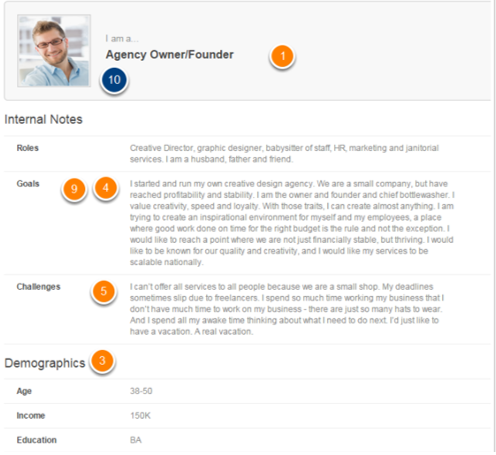5-minute guide to writing the perfect marketing persona

Most marketers already know it's essential to determine a target demographic before launching a campaign. But writing the perfect marketing personas can take this process one step further.
Marketing personas enable a more accurate approach. If your blog posts and offers are only relevant to 1 in 10 of your target demographic, then you're wasting 90% of your time and resources.
As marketing guru, David Meerman Scott told Microsoft: 'Instead of talking about what you do on your websites and in your social networks, create content that helps solve problems for buyers'.
By understanding who your customers are - and what drives their decisions - you can create content that relates to their needs and their position in the purchase journey. This ensures your marketing strategies resonate with those who actually require your services.
In this 5-minute guide, we'll show you how to perfect the art of writing an effective marketing persona.
What is a marketing persona?
Marketing personas are semi-fictional profiles of your ideal customers. Although generalised, the information included within the persona should be based on data and research.
The information you include should enable marketing and sales departments to better understand your target audience.
What should a marketing persona include?
 Putting a name to a face: persona example from HubSpot.
Putting a name to a face: persona example from HubSpot.
Consider these question when planning your marketing personas:
Who are they?
-
- Give your persona a name.
- Provide background information such as job title and previous job roles.
- Include demographic data, including age, gender, income, and location.
- Identify professional identifiers such as how they communicate.
What are their motives?
-
- What are their primary and secondary goals?
- What challenges do they face?
- How can your company solve for them?
- What are some of their most common objections?
Start by creating an elevator pitch that will attract this persona and build from there.
Where do I find this information?
Make the most of your customer database
Research, surveys, and interviews will all shape your personas. The best place to start is with the data you've collected from former and current customers.
By reviewing your database, you'll be able to extract critical information, such as how leads and customers discover your company, and how they consume the content that you produce.
Another important strategy is to gather information from your sales team about the types of prospects they're engaging with most often. Look at what they have in common and try to pinpoint the reasons for these similarities.
Further research techniques include focus groups and surveys, plus website and social media analytics.
Interview for deeper insights
One of the most valuable exercises you can undertake is to interview customers and prospects. Talking to customers with both positive and negative experiences of your company will help you decide how best to attract new prospects.
Next, speak with those who haven't used your services. If you've already collected lead contact information, these prospects will be a good starting point. We suggest conducting a minimum of three interviews to develop more comprehensive personas.
How many personas are needed?
Each persona should represent a segment of your ideal customer base. How you divide up those segments will depend on your business. However, you may find grouping them by sector or goals helpful.
'At Microsoft, we found that for Bing, just nine personas represent 80% of Bing's revenue. That's very manageable.' - Sasha Frljanic, Chief Experience Architect in the Customer and Partner Experience, Microsoft
While creating entire families of personas is tempting, having too many can be a mistake. Each persona should be clearly differentiated, if not - remove it. Begin with one clear persona and build from there. If at any point your personas begin to overlap, consider whether they're part of the same segment.
How do personas fit into my marketing strategy?
Once you've defined your personas, you can map out your content and decide how and where you'll connect with them on their purchase journey.
With clear marketing personas you can reduce the number of poorly-qualified leads at the top of your marketing funnel and ensure you only engage with those ready to commit to your business.
For more information regarding marketing personas and a host of other valuable tools, check out our Marketing Transformation Toolkit.